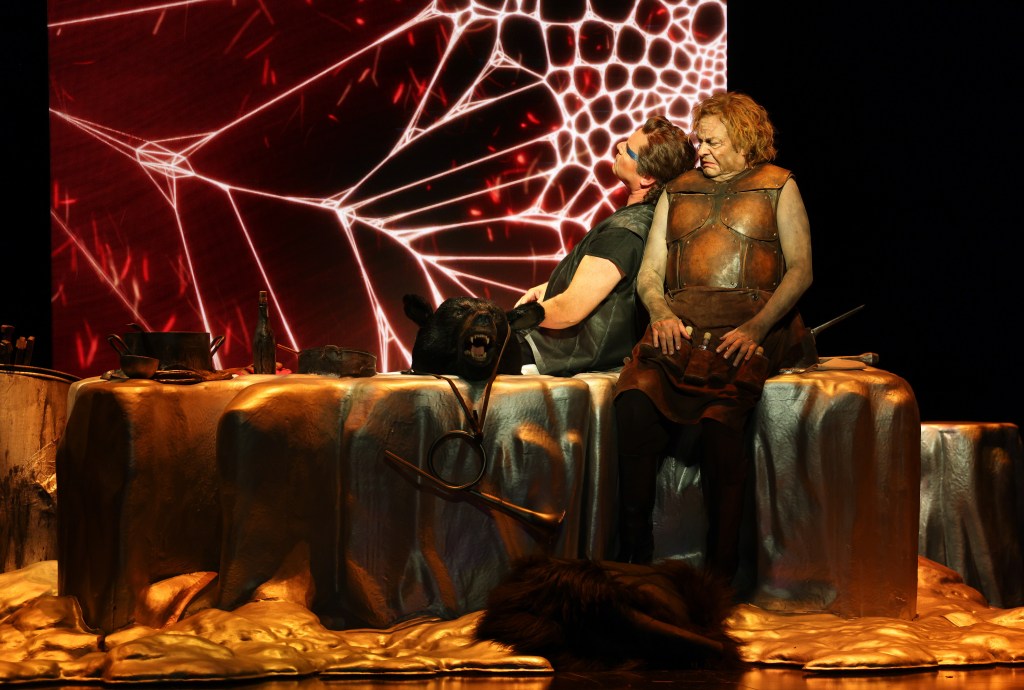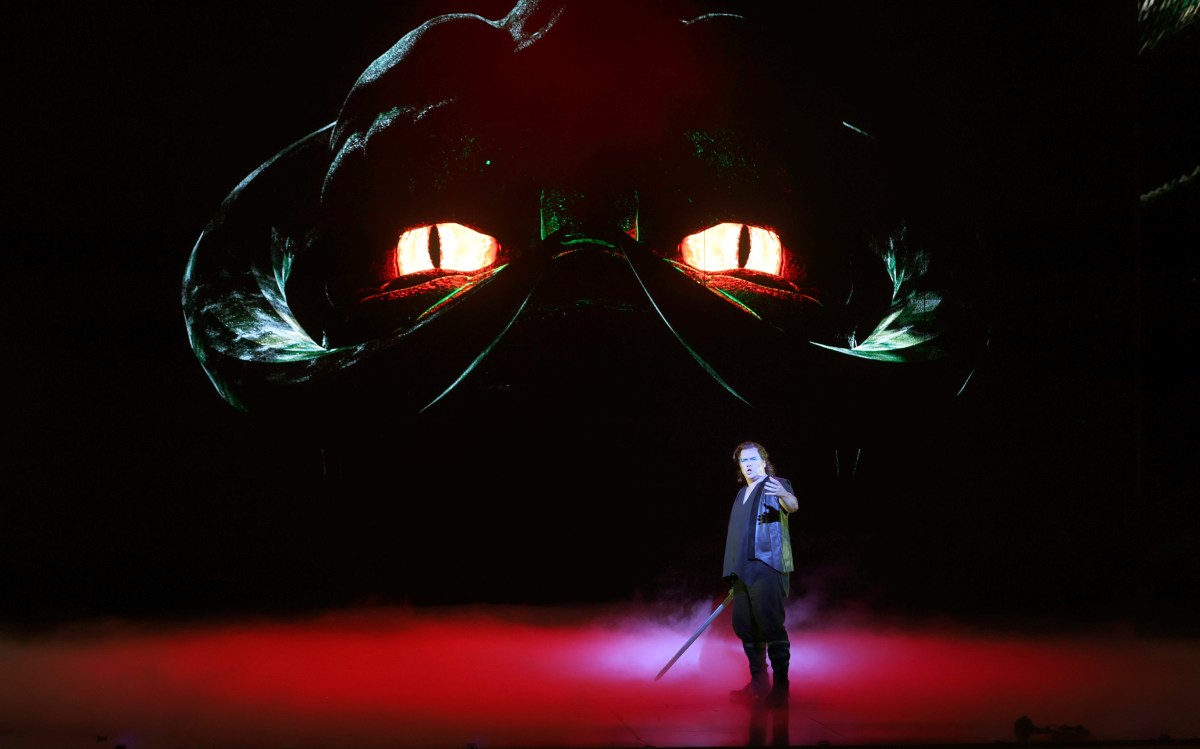Richard Wagner’s third opera in The Ring Cycle is generally considered the most problematic of his four works. Bringing it together created such difficulty for Wagner that he put the work aside for some 12 years, while he wrote Tristan und Isolde and Die Meistersinger. Musically, it is a huge challenge for both singers and orchestra alike. Each of its three long acts is akin to singing an entire opera in its own right with complex music for both dramatic voices and orchestral instruments. Plus, there are technical staging difficulties, such as how to reimagine Fafner as a dragon or show Siegfried conversing with a woodbird in the forest.
The digital imagery created throughout the production of Siegfried at Queensland Performing Arts Centre (QPAC) was for the most part abstract with some marvellous shimmering projections and video content. Created by Digital Content Designer Leigh Sachwitz with content design by flora&faunavisions, the technology produced elements that elucidated and complemented the score.
By projecting an enormous slithering dragon onto many moving screens, our hero Siegfried was able to fearlessly cut through the screens, representing the dragon’s body, to come face to face with him. Andreas Silvestrelli’s Fafner was audio-enhanced as he sung menacingly from offstage, while Siegfried killed his adversary to a dramatic score.
The lyrical scene between Seigfried and woodbird was delightfully represented by an aerial dancer who fluttered charmingly in and out of the trees, followed by flashes of golden and sliver light through darkened trees. Celeste Lazarenko’s woodbird was sung ethereally from offstage and played touchingly on flute. A theatrical device from Wagner allowed Siegfried to understand the bird’s language and the treachery of Mime, while importantly it introduced the notion of Brünnhilde to an eager young hero.
Siegfried’s small cast is unusual in that it concentrates almost entirely on the fortunes and exploits of one person, Siegfried, the son of the union between Siegmund and Sieglinde. The use of repetitive explanation and exposition, often between just a few characters, could make for a static, tedious work over its four hours of music.
Fortunately, Wagner makes his characters more rounded by introducing distinct humour into the work, wanting us to see these characters as being real with human traits. Director Chen Shi-Zheng used this to advantage and brought out some fine dramatic performances from a cast of excellent singers.
The dwarf Alberich and his brother Mime meet unexpectedly in Act II, after Fafner’s death.
Greedy for the gold and unwilling to share, their evil intent as they berated each other offered enjoyable light relief from previous scenes. Siegfried also displayed humour in his scenes with Mime, playfully throwing a bear’s head on the anvil and tossing out broken swords and unrequired tools.
Trying to play a musical leaf when attempting to communicate with the woodbird was fun, the clarinet making appropriate noises. Retrieving his almost-forgotten sword at the end of Act II with a sly wink to the audience, and discovering that Brünnhilde was not a man, were also humorous.
As the opera commenced, we saw the dwarf, Mime, in his workshop desperately trying to repair Siegmund’s sword, Nothung, for young Siegfried.

Andreas Conrad played Mime as a sad, misunderstood character with evil in his heart and only one desire – to win back the ring and gold. In his scenes with both Siegfried, Alberich and the Wanderer (Wotan), his was a performance of great intensity and vocal prowess, with many layers of dramatic complexity. His confusion with the questions set by the Wanderer saw him crumble with fear, while his agitation when his evil intentions towards Siegfried became all too clear elicited audience laughter.
Warwick Fyfe’s Alberich continued to impress, with an enormously strong voice that was rock solid across his range. His dramatic abilities were first-rate and in his scenes with both Wotan and Mime he demonstrated a sly, malicious character finding room for ironic humour.
Daniel Sumegi’s Wotan, disguised as the Wanderer, here swapped his white coat for a full-length black trench coat and fedora hat, giving him an almost Matrix-like persona. Watchful of his adversaries, Sumegi’s exchanges with both Mime and Alberich saw him coolly in control both vocally and dramatically. His scene with Erda, the wise Mother, dramatically played by Liane Keegan and set against a brooding dark red background, however, failed to provide answers.
Encountering Siegfried, who has no regard for politeness and treats the unknown Wotan with disdain, the ensuing fight sees Wotan’s spear broken. This momentous moment in the musical narrative causes Wotan to disappear.
Visually, we saw a poignant flock of birds, harking back to an early image of the union between Siegmund and Sieglinde.
Siegfried then finds and wakes up Brünnhilde in Act III, which is entirely given over to their discovery of each other and of their intense love.
The opera belongs to Siegfried, and Stefan Vinke has sung this role many times to great acclaim, including in Opera Australia’s 2016 version of The Ring Cycle in Melbourne. In many ways he is the perfect Wagnerian tenor, with thrilling top notes and a deeply resonant voice, perfect for the Heldentenor repertoire. He was dramatically strong on stage and equally proficient in the humorous, lighter moments. It is a super-demanding role and he grew visibly both vocally and in stature as the opera proceeded.
His entrance in Act I, having killed a bear, offered us a bumptious, youthful boy totally lacking in guile and completely unaware of his actions or powers. Vocally, he appeared to pace himself here, gradually finding momentum and his musical colours during this act, which strengthened as he forged his sword, Nothung. Breaking the anvil at the end of Act I was a triumphant moment.
He managed many of the key challenges of Act II with aplomb, killing both the dragon and Mime, breaking Wotan’s spear and finding time to enjoy the forest and make friends with the woodbird, an essential element in the narrative. But his pièce de résistance, where he pulled out all the stops vocally, was in the love scene with Brünnhilde, after waking her from a deep sleep.
Anne Louise-Cole, who so impressed with her debut as Brünnhilde in Die Walküre, rose wonderfully to the demands of the dramatic and vocal fireworks that this most difficult of scenes requires. She and Vinke played off each other perfectly, with tremendous skill and wonderful complementary vocal qualities. They appeared to have a terrific rapport, even after just one encounter together in their respective roles. Hesitant to cast off the last vestiges of her immortality in order to give herself to Siegfried, Brünnhilde agonises over the future, while his growing love and infatuation wins her over.
Their respective top Cs gave a rousing end to the opera in the last lines of the duet in praise of ‘radiant love, laughing death!’
Read: Opera review: Die Walküre (The Ring Cycle), QPAC
One felt that Philippe Auguin had taken this score up an orchestral notch since Die Walküre with intense, mostly dark and brooding preludes, powerful drama in the death sequences, alongside the soaring lyrical beauty of Siegfried’s discovery of nature and the ravishing love music between him and Brünnhilde. The orchestra played with great passion and enjoyment. There was some excellent brass playing, including the Wagner tuba and prominent horns. One wonders what other stops they can pull out for Götterdämmerung.
Siegfried (Second day, music drama in three acts)
by Richard Wagner, with libretto by the composer
QPAC
Conductor: Philippe Auguin
Director: Chen Shi-Zheng
Associate Set Designer: Maruti Evans
Digital Content Designer: Leigh Sachwitz, flora&faunavisions
Interactive Content Design and Programming: flora&faunavisions
Costume Designer: Anita Yavich
Lighting Designer: Matthew Marshall
Choreographer: Akasa Ruthy Inchaustegui
Cast: Andreas Conrad, Stefan Vinke, Daniel Sumegi, Andrea Silvestrelli, Warwick Fyfe, Celeste Lazarenko, Liane Keegan, Anna-Louise Cole
Opera Australia Dancers, DanceNorth Australia, Queensland Symphony Orchestra
Siegfried was performed 5, 12, 19 December 2023.
.





